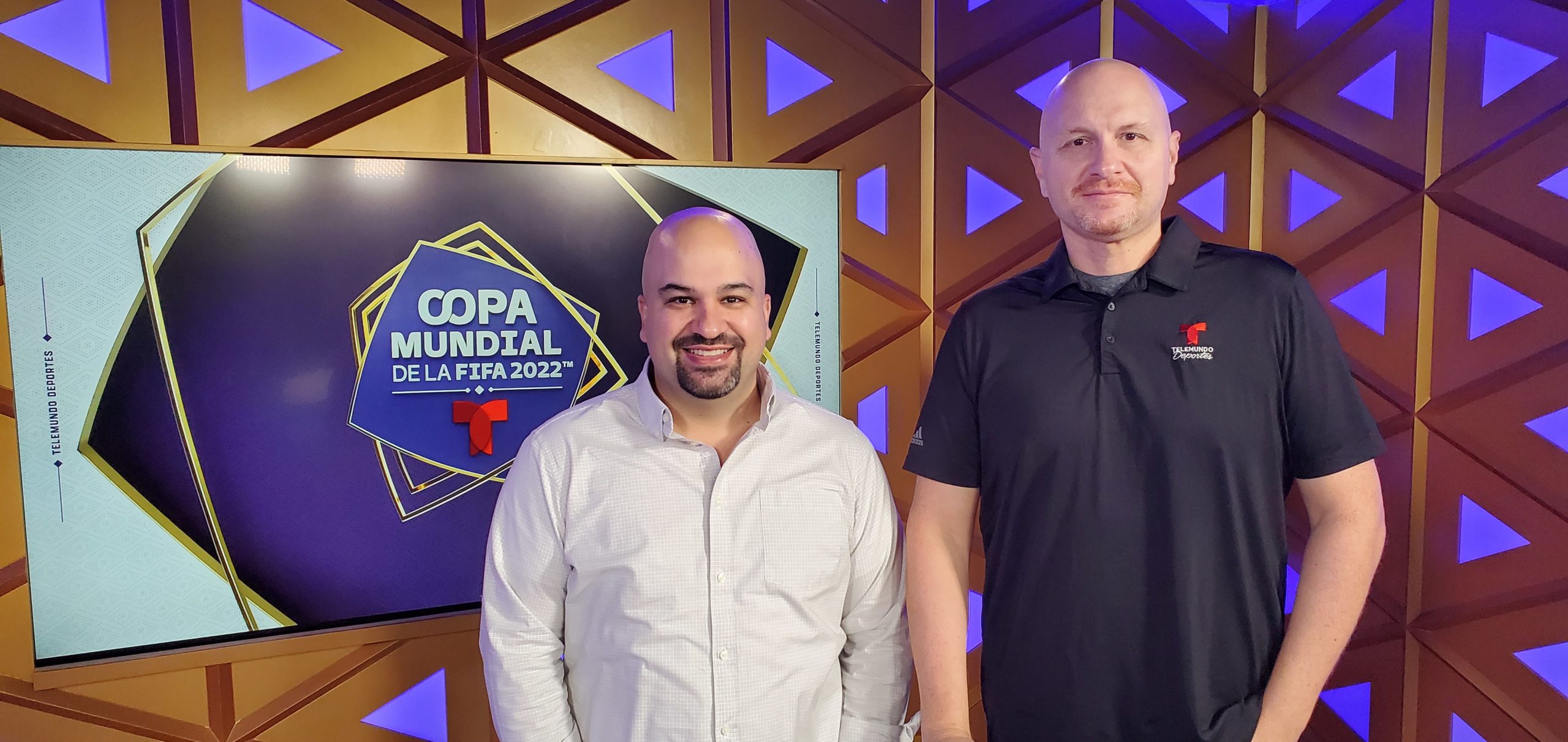Live From FIFA World Cup: Telemundo SVP, Content Operations, Chris Suarez-Meyers Discusses Global Effort
A team in Doha and one in Miami collaborate to provide U.S. viewers all the action from Qatar
The Telemundo Deportes 2022 World Cup efforts literally span the globe. The broadcaster’s Miami-based Telemundo Center produces content 24/7, and its Doha-based team ensures that it gets everything it needs to deliver for Spanish-language viewers in the U.S.
“We are not doing anything other than pushing signals home, to Miami, where we have three production-control rooms managing over-the-air, cable, and our Peacock productions,” says Chris Suarez-Meyers, SVP, content operations, Telemundo Deportes, who is onsite. “We’re pretty much quality control, pass-through, and routing.”
At full strength, the team at the IBC comprises about 80 members and works in a space very similar in size to the one the team had in Russia for the 2018 World Cup. Production-control rooms and other content-creation and -playout areas in Miami receive signals from the IBC that originate from a variety of sources: the HBS multi-lateral feeds, studio operations throughout Doha, ENG crews. The team in Doha is almost as culturally diverse as the World Cup teams themselves, with Telemundo staffers hailing from 29 countries.
“In Miami,” says Suarez-Meyers, “things run around the clock between over-the-air, digital, and streaming, and the post work never stops. Coming out of the elections right into World Cup mode is a big swing for the technical teams in [Miami], but so far so good. They’re professionals and are handling it like champs.”
From day one, he adds, the decision was to push all the audio and video signals to Miami. That includes all HBS feeds, as well as unilateral cameras, signals from bookable positions at the venues, from the studios, Fan Fest, and even the unilateral hotel position inside the Souq Waqif marketplace.
The biggest change from previous World Cups is the smaller overall footprint of the World Cup, with stadiums only a quick drive apart.
“Having everyone in one city has proven to be a huge force multiplier,” Suarez-Meyers notes. “We can scale up, scale down, and move people around with a quick WhatsApp message. We can change plans without having to wait for people to land in outer cities or figure out a logistics plan. It’s, Hey, I need three extra ENG crews to go to LuSail Stadium or I need two crews to go to the match- minus-one training. The fact that [the crews are] wearing LiveU backpacks and everything is sent back to Miami in an instant has made things a lot easier and more flexible for us.”
The benefits extend well beyond giving the production team more flexibility: it helps keep the team fresher. “It’s less wear and tear on the team,” he says, “because they don’t have to pack, get on a plane, unpack, get in a small car, drive to the stadium, wait in line. It makes things a lot easier, and they can always come back to their bed, and that goes a long way.”
According to Jorge Duarte, senior director, product engineering, Telemundo Deportes, Ooredoo provides connectivity within Qatar, and ATT provides redundant long-haul fiber services via London and Frankfurt. “Everything we planned for worked out the way we intended it to, and latency wasn’t an issue, so we’re doing everything from Miami. We expected some hurdles but we haven’t had any.”
Although HDR coverage isn’t making it to viewers, it is being sent to Miami for testing. “Everything in-bound to us from HBS is in 1080p HDR,” Duarte explains. “We convert it down to SDR and HDR. We also decided not to go 2110 this time around. We go back to baseband for transmission as it didn’t make a whole lot of sense given what we’re doing here.”
Telemundo’s IBC facility has a dedicated VAR room, where referees can see all the feeds the officials see, and a flash position with a robotic camera controlled from Miami and able to be fired up at a moment’s notice.
“We just put [the referee] in front of the [flash-position] camera and call Miami, which takes control of it,” says Suarez-Meyers. “If there is a controversial play, [the referee] can come out of their booth for halftime or postmatch, stand in front of the camera, and get their analysis on-air.”
Telemundo’s broadcast-operations area in Doha is much larger than its facility in Russia as there is no production control room this time around. At the front bench, three BOC techs rotate morning, day, and night and also check the commentary cameras at each stadium.
“We have commentary positions at all 64 matches all eight venues,” says Suarez-Meyers. “As the games get more important, we’ll have more activations inside the stadiums. We also have a permanent studio position at Lusail Stadium.”
The team at the IBC coordinates with Miami to ensure that the team there knows everything they are supposed to receive and are receiving it properly.
“We also have returns from Miami so we can see what they’re seeing,” adds Duarte. “Everything is also being recorded back home; we do have very limited recording here for troubleshooting purposes.”
The IBC is connected to the studio at the HBS Outside Presentation Facility, which has a main studio and a presentation platform overlooking the Corniche. Telemundo also has a stage at the Fan Festival, with a roaming camera, and another stage in a hotel.

